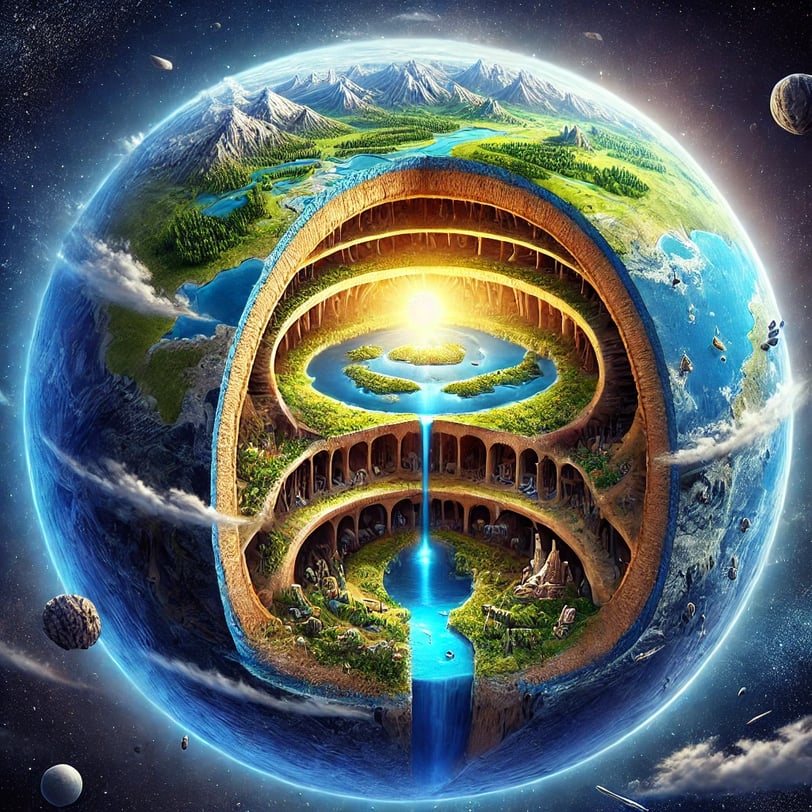The Hollow Earth Theory: Myth, Science, and Speculation
The Hollow Earth theory is one of the most intriguing and controversial hypotheses regarding the structure of our planet. While modern geology firmly establishes that Earth consists of a solid crust, mantle, and core, alternative theories have suggested that vast subterranean spaces—or even an entirely hollow interior—exist beneath our feet. This article explores the origins of the Hollow Earth theory, its various interpretations, and the scientific evidence that challenges its validity.
2/27/20252 min read


Origins of the Hollow Earth Theory
The concept of a Hollow Earth dates back centuries, rooted in mythology, philosophy, and early scientific thought.
Ancient Myths and Legends: Many ancient civilizations, including the Greeks, Hindus, and Native Americans, have myths of underground realms inhabited by supernatural beings. The Greeks spoke of the underworld ruled by Hades, while Hindu traditions mention Shambhala, a hidden city beneath the Earth.
Edmund Halley's Model (17th Century): The astronomer Edmund Halley proposed that Earth was composed of multiple concentric spheres, with hollow spaces in between. He suggested that the Aurora Borealis was caused by luminous gases escaping from Earth's interior.
John Cleves Symmes Jr. (19th Century): The Hollow Earth theory gained popularity in the 19th century when American officer John Cleves Symmes Jr. claimed that Earth was entirely hollow and contained a habitable inner world. He even advocated for an expedition to find entrances at the poles.
Jules Verne's Fictional Influence: "Journey to the Center of the Earth" (1864) by Jules Verne popularized the idea of vast subterranean worlds, influencing both fiction and fringe science.
Different Interpretations of the Hollow Earth Theory
Throughout history, various versions of the Hollow Earth concept have emerged, each with unique assumptions.
Classical Hollow Earth: A completely hollow planet with an internal sun, sometimes believed to house an advanced civilization.
Subterranean Cavern Networks: Some theories propose massive underground cities and ecosystems rather than a fully hollow Earth.
Polar Entrances Theory: Symmes and later believers argued that vast openings at the North and South Poles provided access to the inner world.
Agartha and Shambhala: Theosophical and esoteric traditions claim that an advanced, enlightened race inhabits subterranean cities, influencing humanity from below.
Conspiracy Theories: Some modern theorists suggest that governments and military forces are aware of Hollow Earth secrets and suppress information.
Scientific Analysis: Why the Hollow Earth Theory is Implausible
Modern geophysical and geological studies overwhelmingly refute the Hollow Earth hypothesis.
Seismic Data: Earthquake waves travel at varying speeds through different layers of the Earth, confirming the presence of a solid mantle and core.
Gravitational Evidence: A hollow planet would not have the necessary mass to produce the gravitational pull we experience.
Heat and Pressure: The extreme heat and pressure deep within the Earth, as evidenced by volcanic activity, make the existence of habitable hollow spaces impossible.
Magnetic Field: Earth's magnetic field is generated by the motion of molten iron in the outer core. A hollow Earth would not produce this effect.
Alternative Scientific Theories and Exploration of the Subsurface
Although the classical Hollow Earth theory is scientifically untenable, there are legitimate scientific explorations of underground environments.
Deep Biosphere Studies: Scientists have discovered microbial life thriving in deep rock layers, expanding our understanding of Earth's habitability.
Massive Cave Systems: Vast underground networks, such as the Mammoth Cave system in the U.S. and Vietnam's Son Doong cave, provide insights into Earth's hidden realms.
Drilling Projects: Initiatives like the Kola Superdeep Borehole (Russia) and oceanic drilling missions continue to probe deeper into Earth's crust, offering valuable geological data.
Conclusion
While the Hollow Earth theory remains a fascinating subject in mythology, science fiction, and conspiracy circles, modern geology and physics have decisively debunked it. However, the exploration of Earth's underground world continues to yield surprising discoveries, demonstrating that truth can be just as remarkable as fiction. The ongoing study of deep-Earth environments helps scientists understand not only our planet but also the potential for subterranean life on other worlds.
Explore
Discover diverse topics in one convenient hub.
Connect
Learn
contact@mindstormblog.com
© 2025. All rights reserved.


